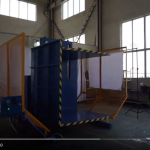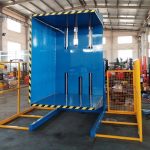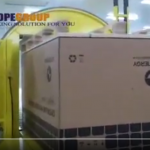Pallet Inverter Integration: How to Connect It with Existing Systems
- Pallet Inverter Integration: How to Connect It with Existing Systems
- 1. Understanding Pallet Inverter Basics
- 2. Why Integration Matters
- 3. Mapping Out Existing Systems
- 4. Determining the Right Location
- 5. Ensuring Compatibility with Conveyor Systems
- 6. Integrating Forklift and AGV Operations
- 7. Software Integration: The Key to Efficiency
- 8. Customization for Specific Industry Needs
- 9. Training for Seamless Operation
- 10. Safety Considerations in Integration
- 11. Maintaining Flexibility in Operations
- 12. Monitoring Performance After Integration
- Conclusion: Maximizing Value Through Proper Integration

In modern warehousing and logistics, efficiency is paramount. One key piece of equipment that enhances both efficiency and safety is the pallet inverter. However, for businesses to truly benefit from this technology, integrating it with their existing systems is crucial. Proper integration not only improves operational workflows but also ensures that the investment in a pallet inverter delivers a high return. In this guide, we will explore the ins and outs of pallet inverter integration, providing a step-by-step overview of how to connect it seamlessly with your current processes.
1. Understanding Pallet Inverter Basics
Before diving into the integration process, it’s important to understand what a pallet inverter does. A pallet inverter is designed to rotate loaded pallets 180 degrees to switch out damaged or incompatible pallets without the need to unload products manually. This eliminates risks associated with manual handling and significantly speeds up the process of pallet changing, especially in large-scale operations. Integrating this device into existing systems can maximize productivity while reducing labor costs and minimizing product damage.
2. Why Integration Matters
Effective integration of a pallet inverter ensures that it works in tandem with your existing material handling systems, including conveyors, forklifts, and pallet wrapping machines. Without integration, you may experience bottlenecks, inefficiencies, and underutilization of the equipment. Seamless integration allows the pallet inverter to become an active part of the automation process, reducing downtime and maximizing throughput.
3. Mapping Out Existing Systems
The first step to integrating a pallet inverter is conducting a thorough analysis of your current systems. This involves mapping out all your material handling processes, including the flow of goods from storage to shipping. Are there any existing automated systems, such as conveyors or automated guided vehicles (AGVs), in place? What manual processes do you have, and how will they be impacted by automation? By understanding the layout and logistics, you’ll be able to identify where the pallet inverter fits within the broader operation.
4. Determining the Right Location
Location is key when integrating a pallet inverter into your operation. Placing it in the correct spot can optimize the flow of pallets and ensure smooth transitions from one process to another. Typically, the best place to install the inverter is at the beginning of the packing or shipping line, where pallet changes are frequent. However, every facility is unique, and the placement must align with existing processes to avoid disruptions.
5. Ensuring Compatibility with Conveyor Systems
If your warehouse relies heavily on conveyor systems for transporting goods, ensuring compatibility with the pallet inverter is vital. Some pallet inverters can be configured to work directly with conveyor belts, but others may require modifications. This might include the installation of a custom loading platform or adjustments to the speed and alignment of the conveyor system to accommodate pallet rotation.
Key Consideration: Conveyor systems should be calibrated to handle the rotation speed and weight capacity of the pallet inverter, ensuring that there is no lag or delay in the handling process.
6. Integrating Forklift and AGV Operations
Many warehouses use forklifts and AGVs to transport pallets from one area to another. Proper integration with a pallet inverter requires that forklift operators and AGV systems are trained to work in sync with the inverter. This involves creating clear workflows where forklifts and AGVs deliver pallets to the inverter and retrieve them once the process is complete.
A common integration challenge is timing—forklifts or AGVs may arrive at the inverter before the previous process has finished, creating delays. Coordination through software and communication systems is key to maintaining a smooth flow of operations.

Get Your Best Solution !
7. Software Integration: The Key to Efficiency
One of the most critical aspects of integrating a pallet inverter with existing systems is ensuring that it connects seamlessly with Warehouse Management Systems (WMS) or other automation software. A WMS controls the flow of inventory, and integrating a pallet inverter with it will ensure that the process of pallet changing is logged and automated. This can reduce human error, track product movements in real-time, and even generate reports on system performance.
Pro Tip: Ensure your WMS is compatible with the automation system used by the pallet inverter. If they don’t speak the same language, you might need to invest in middleware that enables communication between different systems.
8. Customization for Specific Industry Needs
Different industries have unique requirements when it comes to material handling. For example, the food and beverage sector might require pallet inverters to work within cold storage environments, while the pharmaceutical industry may need inverters that comply with strict sanitation standards. When integrating a pallet inverter, it’s crucial to customize it according to your specific industry’s standards. This could involve using stainless steel models for hygiene, incorporating dust-proof seals, or ensuring temperature resilience.
9. Training for Seamless Operation
While pallet inverters can streamline many processes, improper use or lack of training can lead to downtime and inefficiencies. It’s essential to train all operators and warehouse staff on how to use the pallet inverter and understand its role in the integrated system. This includes:
- Understanding the operating controls
- Following safety procedures
- Learning how to handle emergencies or malfunctions
- Ensuring the system is regularly maintained to prevent breakdowns
Tip: A successful integration doesn’t just stop at installation. Regular training updates should be part of your operational routine to account for any changes in processes or technology upgrades.
10. Safety Considerations in Integration
Any integration of new equipment must take safety into account. Pallet inverters, especially in heavy-duty environments, can present hazards if not properly installed or integrated with existing systems. Ensure that all safety protocols are in place, such as emergency stop buttons, protective barriers, and operator training. Conduct regular safety audits to ensure that the integration remains compliant with industry standards and OSHA regulations.
11. Maintaining Flexibility in Operations
A well-integrated pallet inverter should enhance the flexibility of your operation. This means it should be adaptable to handle different types of pallets, loads, and materials. When designing the integration, consider potential future needs—such as handling heavier loads or adapting to new packaging materials—and ensure that the inverter and the systems it connects with can accommodate these changes.
12. Monitoring Performance After Integration
Once your pallet inverter is integrated into your existing system, continuous performance monitoring is critical. Use your WMS or any other connected software to track key performance indicators (KPIs) such as:
- Downtime rates
- Cycle times for pallet changing
- Incidences of product damage
- Overall throughput
By regularly reviewing these metrics, you can identify any bottlenecks or inefficiencies and make necessary adjustments to improve overall performance.
Conclusion: Maximizing Value Through Proper Integration
Integrating a pallet inverter into your existing systems is not just about improving pallet-changing processes—it’s about enhancing the overall efficiency and safety of your warehouse operations. When done correctly, this integration can significantly reduce labor costs, minimize product damage, and streamline workflows. By ensuring compatibility with existing systems, investing in necessary software connections, and providing adequate training, you can fully unlock the potential of your pallet inverter.
In today’s fast-paced logistics environment, proper integration is the key to staying competitive. By taking a strategic approach and planning ahead, your pallet inverter will not only function as a standalone piece of equipment but become an integral part of a smarter, more efficient supply chain.
By focusing on seamless integration, safety considerations, and monitoring performance, you can ensure that your pallet inverter maximizes operational productivity while minimizing downtime and costs.

Get Your Best Solution !








